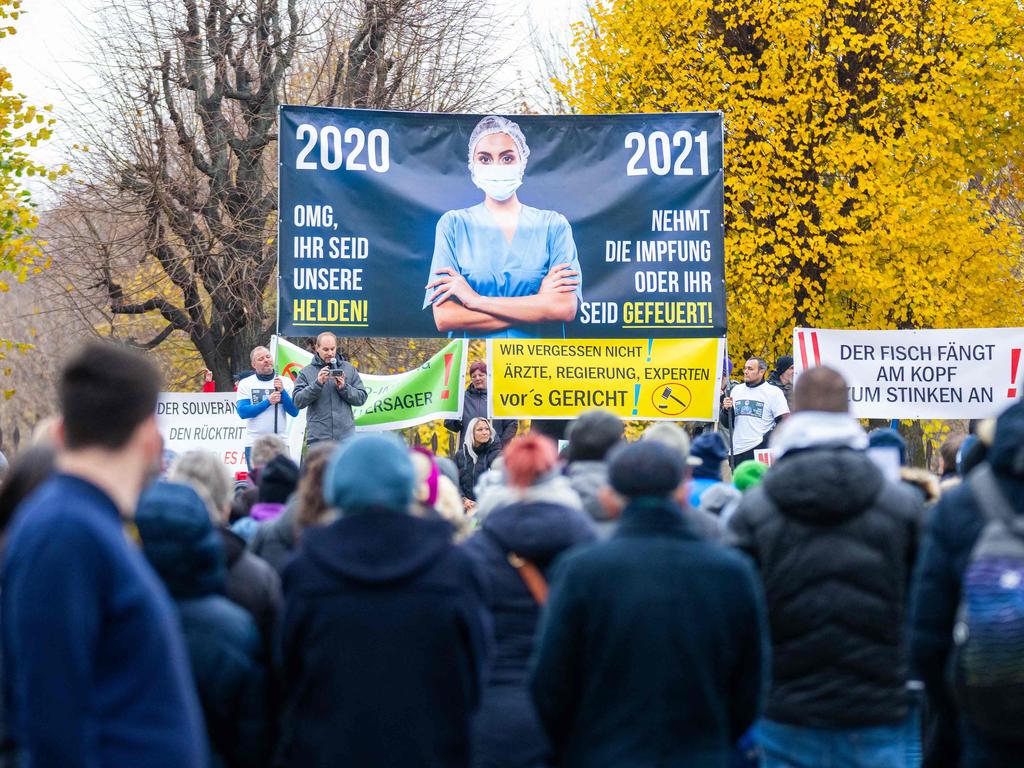
Across the Western world, from the streets of France and cable television shows in the US to the floor of Australia’s parliament, anti-vaxxers are invoking allusions to Nazi horrors to prosecute their arguments.
In a recent speech, Nationals backbencher George Christensen likened state Covid restrictions to Nazi Germany. “The totalitarian regimes responsible for the most heinous atrocities in the 20th century – think Stalin, Mao, Hitler, Pol Pot – they didn’t get there overnight,” he said. “In 21st-century Australia, state premiers are racing down that familiar path.”
At protests, anti-vaxxers have taken to wearing yellow Stars of David, casting themselves as a beleaguered minority persecuted by the state.
In the US, a Fox News host has compared Anthony Fauci to Josef Mengele, the “Angel of the Death” at Auschwitz. Comparisons between vaccine mandates and the Holocaust are rife on social media, where outrage is a currency, and paranoia is rewarded.
Misuse of the memory of the Holocaust has driven the Auschwitz Memorial Project, run by the Auschwitz-Birkenau Memorial and State Museum in Poland, to put forward a rare condemnation: “Exploiting the tragedy of people who became victims of criminal pseudo-medical experiments in Auschwitz in a debate about vaccines, pandemic and people who fight for saving human lives is shameful. It is disrespectful to victims & a sad symptom of moral and intellectual decline.”
Such comparisons are also symptomatic of historical illiteracy. Nazi ideology had particular features specific to a particular place and time that cannot be shoehorned into today’s culture wars. Nor can the horrors of the Holocaust be compared to inconveniences such as wearing a mask or scanning a QR code.
And contrary to the assertions of anti-vaxxers, vaccine mandates were not Nazi policy at all. In fact the Nazis relaxed the compulsory vaccination requirements that had been in place in Germany for decades when they came to power in 1933. The Nazis also gutted the medical profession, purging Jewish and female doctors estimated to comprise about one-third of the medical workforce.
As a result, mortality and morbidity from infectious diseases rose sharply. Deaths from diphtheria doubled between 1933 to 1937, and scarlet fever, spinal meningitis, infantile paralysis, typhoid and paratyphoid increased as well. Hospital mortality figures rose by an estimated 16 per cent and life expectancy declined.
Rather than protecting the weakest and most vulnerable members of society from disease – which today’s Western governments have tried to do with lockdowns and vaccination mandates – the Nazis pursued a project of ruthless social Darwinism. In 1939, they began a program of mass euthanasia in hospitals for sick and disabled children. After 5000 children had been murdered, this program was extended to adults who were housed in Germany’s psychiatric hospitals. Far from forcing vaccinations on to the unwilling, the Nazis kept them from those who they considered inferior. In the book Hitler’s Table Talk, Hitler is quoted as saying vaccinations “were to be confined to Germans alone”. Russians and Slavs in territories that were conquered by the Nazis were to be excluded. “Russians don’t grow old. They scarcely get beyond fifty or sixty. What a ridiculous idea to vaccinate them,” Hitler reportedly said.
When it came to the persecution of Jews, the overcrowded and unsanitary conditions of the ghettos were not accidental. Thousands died from infectious disease outbreaks. During an outbreak of typhus, in the Kovno ghetto of Lithuania, the Nazis sealed the hospital from the outside and set it on fire, burning the hospital to the ground, with patients and doctors inside.
While depriving “inferiors” of medicine, the Nazis set up a state-sponsored alternative medicine industry. Obsessed with purity, they encouraged the eating of “natural food” from “German soil”. The largest herb garden in Europe was grown at Dachau.
Alternative medical practitioners, folk healers, herbalists and homeopaths were allowed to register alongside medical doctors under the umbrella of Heilpraktiker (practical healers). Hitler preached the virtues of vegetarianism (although he couldn’t resist his favourite dish of liver dumplings). Like anti-vaxxers of today, who unironically call themselves “purebloods”, Nazi ideology suffered from the naturalistic fallacy – that is, what is natural must be good.
All decent people can agree that the inconveniences caused by Covid restrictions should never be compared to the genocide and torture of millions of European Jews. But we live in an era of entitlement and outrage, and our understanding of history is shallow and simplistic.
The Nazis fused mysticism and the occult with a mythological reading of German history and pseudoscientific ideas about racial purity. In this way, historian Eric Kurlander argues, they were able “to pick and choose the characteristics they would like to ascribe to their enemy, comparing them to vampires, zombies, devils, and demons”.
Societies that have protected the vulnerable from infectious disease, whether they are elderly, infirm, disabled or Indigenous and living in remote or regional communities, are not comparable to those who would dismiss such deaths on the basis that the strong deserve to live more than the weak. The true measure of society is how it treats its most vulnerable members.
And while the pandemic and the restrictions imposed on us to combat it have been hard, people throughout history have lived with grief and suffering on a scale we can scarcely imagine.
Claire Lehmann is founding editor of Quillette.








The pandemic that began at the start of last year now stretches into its third. Most of us are exhausted by the check-ins, restrictions and surveillance. We’ve had our shots, stayed at home, sacrificed special occasions and home-schooled our kids. But as new variants emerge and boosters are required to keep the virus in check, the rhetoric emerging from anti-vax advocates is taking a more sinister turn.